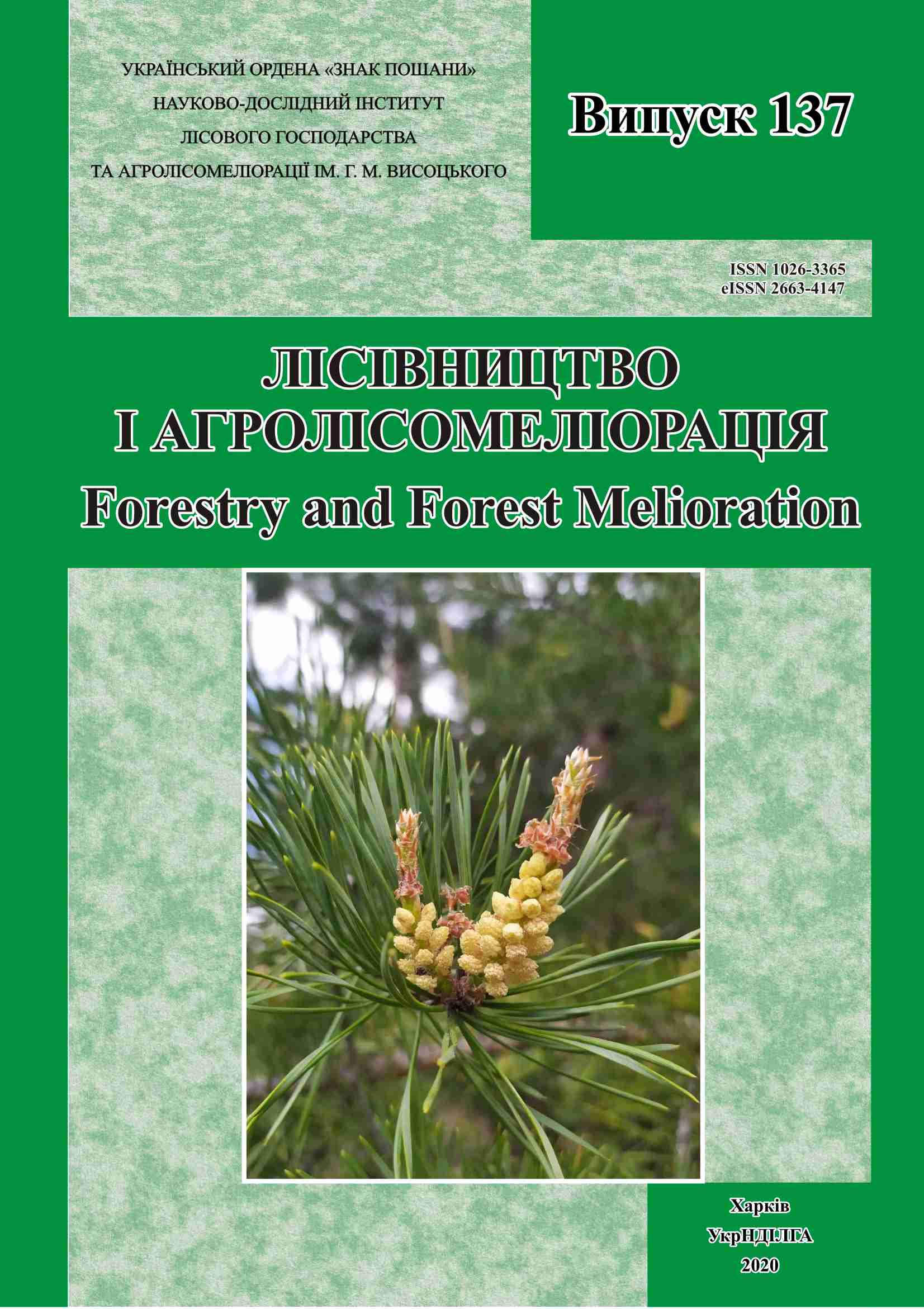Abstract
Introduction
The data on forest pathological processes dynamics in the stands managed by the state forestry enterprises were generalized in the study. The results indicate a gradual increase in the scale of pathological processes and, accordingly, an increase in the amount of sanitary measures taken in the stands. In recent years, especially in Western and Central Polissia in Ukraine, there has been a massive dying of pine stands caused by invasion of apical bark beetles. As a result,there is a significant increase in sanitation felling. Outbreaks of stem pests occurred along with chronic root rot foci, periodic fires, windbreaks, windthrows, and snowbreaks. Deterioration of pine stands occurs due to their simplified structure and is brought about by climate change. Significant areas of the pine stands covered with large-scale pathological processes and major material losses point at a necessity to reduce the stands’ maturity age.
The aim of the research was to determine the age range of pathological processes in pine stands.
Materials and Methods
Changes in the condition of the pine stands in Volyn Region were observed for the period 1992–2018 by means of the database information analysis as of every third year since 1994. The collected data include the areas of the stands with certain pathological processes, their assessment indicators, the reasons which initiated a pathological process, and forestry measures and their consequences. The forestry enterprises specialists determined the reasons for the deterioration of the condition of the stands. The list included about 60 different factors, some of which were grouped together. To assess the extent of pathological processes, the area of one or another dying species as a percentage of the total area covered by it was considered as follows: 0.1–2.4% – weak;
2.5–5.0% – average; 5.1–10.0% – strong; 11–15% – very strong; 15.1–20.0% – critical; > 20.0% – ecological catastrophe. The general age dynamics of the pine stands was determined as of 2011 according to the Forest Fund of Ukraine and compared with the age dynamics of the pine stands with pathological processes.
Results
The vast majority of the pine stands in Volyn Region was established in the 1950s–60s. These are mainly pure in composition or nearly pure stands of natural and artificial origin (80–100 % of pine) which cover respectively 73.2 % and 80.6 % of the area. Among the stands of different species in which pathological processes were observed as of 2018 in the forests of Volyn Region, pine stands occupy more than 80 %. In the total forest area of Volyn Region pine plantations make 57 %. The data show that the dying pine stands make 15 % of all pine stands. A proportion of pine stands with pathological processes in the total area of dying stands exceeds the percentage of pine-covered areas by 24 %. The general dynamics of the area of pine stands dying in one or another degree for the period 1994–2018 shows that from 2000 to 2009 their area varied from 4,700 ha to 5,500 ha, which points at a low resistance to pathological processes. Since 2012, the scale of pathological processes had increased and as of 2018 reached almost 34 thousand hectares due to an outbreak of apical bark beetle (Ips acuminatus). In general, during all the years of observation, the main factor initiating dying of the pine stands in Volyn Region was root rot by Heterobasidion annosum (Fr.) Bref. The most severe wind damage to the pine stands took place in the periods as of 2000 (467 ha – 8.7 %), 2003 (114 ha – 2 %) and 2009 (655 ha –14 %). Damage of pines of Volyn Region by fires was noted in the period 2000–2009 and the worst large-scale fires took place as of 2000 – 449 hectares (8 % of the area of all stands died in this period). Damage to root systems and overgrowth of crown branches can many times exceed the area of pine trees with visible signs, which, in our opinion, may be the basis for the spread of apical bark, the stock of which is always in chronic foci of root rot by Heterobasidion annosum (Fr.) Bref., whose area since 2000 reaches 3,500–4,000 ha. The scale of distribution of forest pathological processes in the pine stands of different age classes shows that the largest part of dying forests are stands of VI and VII age classes: 41% and 24%, respectively. On the other hand, the percentage of areas of all pine stands of VI and VII age classes in the total distribution of pine trees by age classes is significantly lower: by 26% and 15%, respectively, indicating a low biological resistance of artificial pine stands older than 50 years old.
Conclusions
As of 2012, the area of dying pine stands in Volyn Region increased sharply due to a mass reproduction of apical bark beetle (Ips acuminatus) and in 2018 it reached almost 34,000 ha. The largest percentage of the pine stands dying to one or another degree are stands of VI and VII age classes (41 % and 24 %), and the percentage of areas of all pines of VI and VII age classes in the general distribution of pines by age classes in Volyn Region is significantly smaller, respectively 26 % and 15 %, which indicates a low biological resistance of artificial pine stands at this age, and a necessity to reduce age of felling of such stands to 51–70 years. From the pine stands of I–VI age classes in Volyn Region, 70–90 % were established artificially; more than 80% of them were pure or nearly pure in composition. About 48 % of all pines in Volyn Region are vulnerable to pathological processes.
3 Figs., 3 Tables, 11 Refs.
Key words: pathological processes, Scots pine forests, forest decline, root rot, Ips acuminatus.

This work is licensed under a Creative Commons Attribution 4.0 International License.
